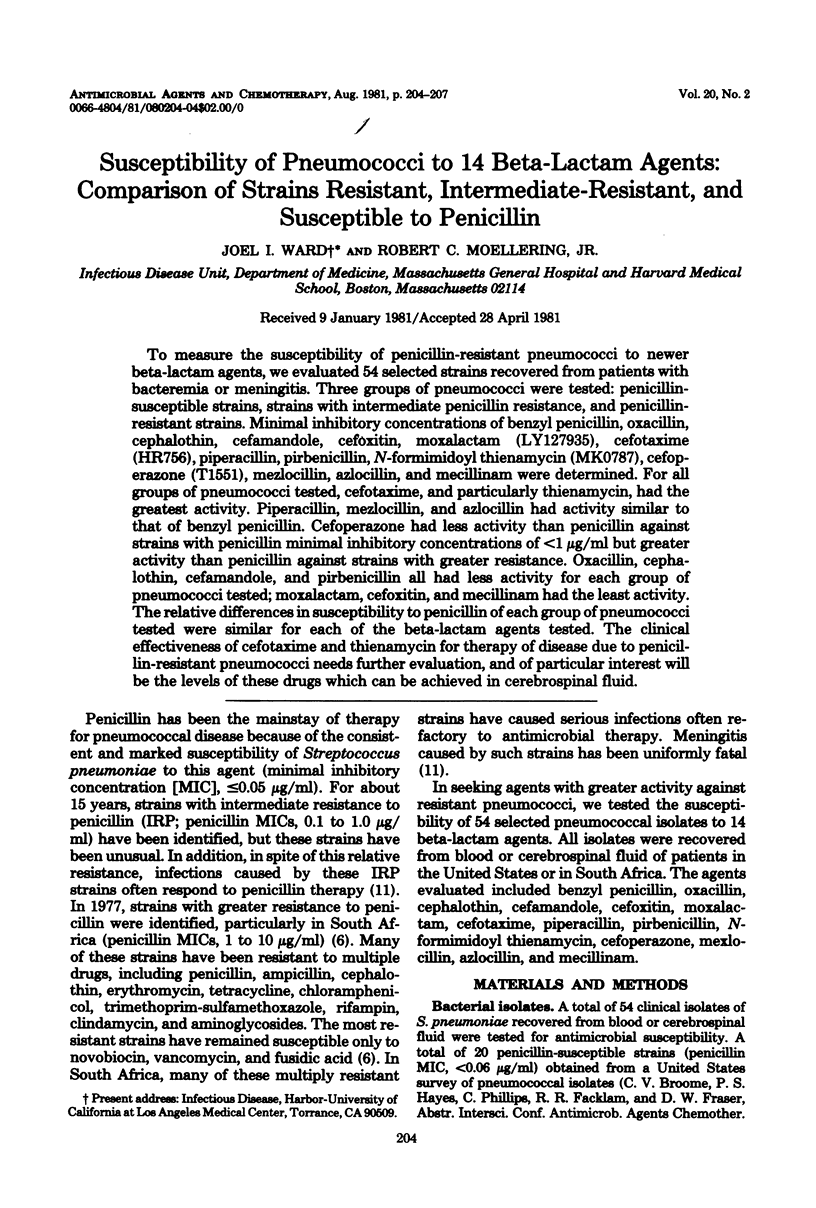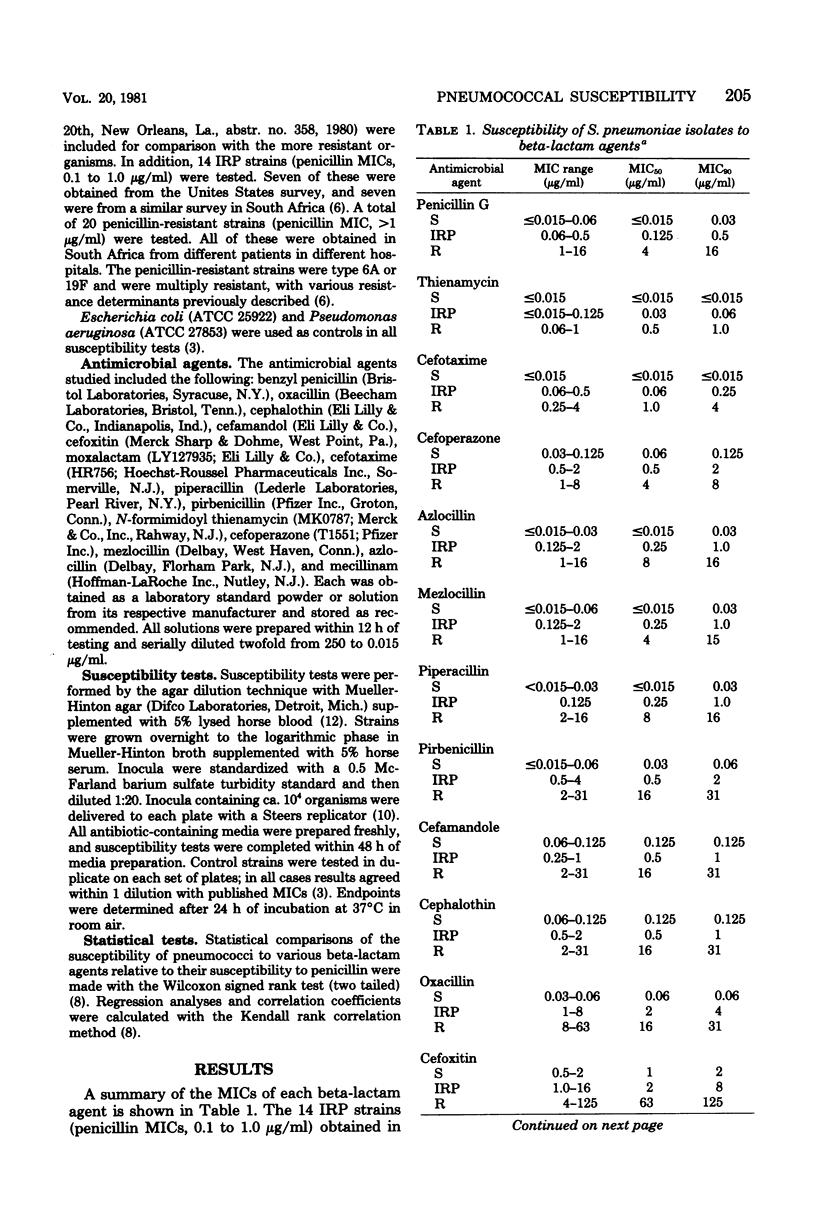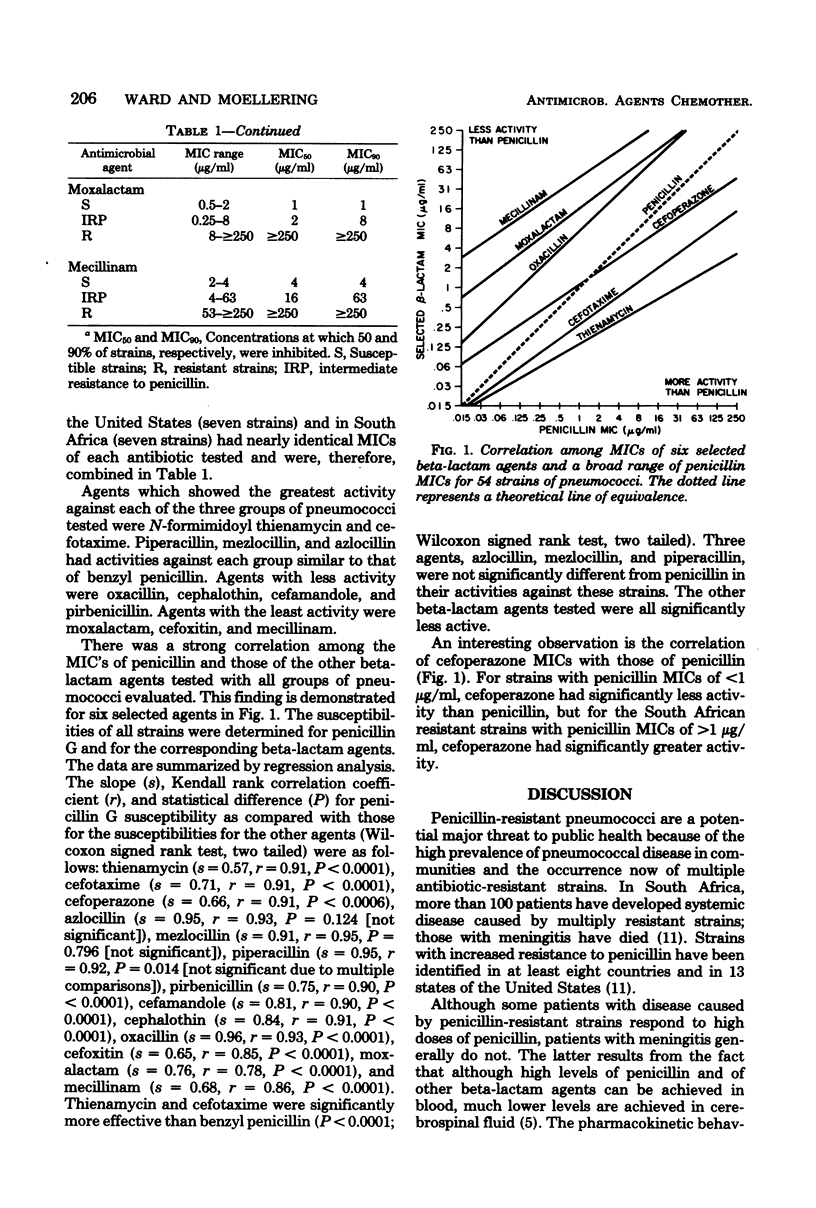Abstract
To measure the susceptibility of penicillin-resistant pneumococci to newer beta-lactam agents, we evaluated 54 selected strains recovered from patients with bacteremia or meningitis. Three groups of pneumococci were tested: penicillin-susceptible strains, strains with intermediate penicillin resistance, and penicillin-resistant strains. Minimal inhibitory concentrations of benzyl penicillin, oxacillin, cephalothin, cefamandole, cefoxitin, moxalactam (LY127935), cefotaxime (HR756), piperacillin, pirbenicillin, N-formimidoyl thienamycin (MK0787), cefoperazone (T1551), mezlocillin, azlocillin, and mecillinam were determined. For all groups of pneumococci tested, cefotaxime, and particularly thienamycin, had the greatest activity. Piperacillin, mezlocillin, and azlocillin had activity similar to that of benzyl penicillin. Cefoperazone had less activity than penicillin against strains with penicillin minimal inhibitory concentrations of less than 1 microgram/ml but greater activity than penicillin against strains with greater resistance. Oxacillin, cephalothin, cefamandole, and pirbenicillin all had less activity for each group of pneumococci tested; moxalactam, cefoxitin, and mecillinam had the least activity. The relative differences in susceptibility to penicillin of each group of pneumococci tested were similar for each of the beta-lactam agents tested. The clinical effectiveness of cefotaxime and thienamycin for therapy of disease due to penicillin-resistant pneumococci needs further evaluation, and of particular interest will be the levels of these drugs which can be achieved in cerebrospinal fluid.
Full text
PDF



Selected References
These references are in PubMed. This may not be the complete list of references from this article.
- Cooksey R. C., Facklam R. R., Thornsberry C. Antimicrobial susceptibility patterns of Streptococcus pneumoniae. Antimicrob Agents Chemother. 1978 Apr;13(4):645–648. doi: 10.1128/aac.13.4.645. [DOI] [PMC free article] [PubMed] [Google Scholar]
- Dixon J. M., Lipinski A. E., Graham M. E. Detection and prevalence of pneumococci with increased resistance to penicillin. Can Med Assoc J. 1977 Nov 19;117(10):1159–1161. [PMC free article] [PubMed] [Google Scholar]
- Fass R. J., Barnishan J. Minimal inhibitory concentrations of 34 antimicrobial agents for control strains Escherichia coli ATCC 25922 and Pseudomonas aeruginosa ATCC 27853. Antimicrob Agents Chemother. 1979 Nov;16(5):622–624. doi: 10.1128/aac.16.5.622. [DOI] [PMC free article] [PubMed] [Google Scholar]
- Hakenbeck R., Tarpay M., Tomasz A. Multiple changes of penicillin-binding proteins in penicillin-resistant clinical isolates of Streptococcus pneumoniae. Antimicrob Agents Chemother. 1980 Mar;17(3):364–371. doi: 10.1128/aac.17.3.364. [DOI] [PMC free article] [PubMed] [Google Scholar]
- Hieber J. P., Nelson J. D. A pharmacologic evaluation of penicillin in children with purulent meningitis. N Engl J Med. 1977 Aug 25;297(8):410–413. doi: 10.1056/NEJM197708252970802. [DOI] [PubMed] [Google Scholar]
- Jacobs M. R., Koornhof H. J., Robins-Browne R. M., Stevenson C. M., Vermaak Z. A., Freiman I., Miller G. B., Witcomb M. A., Isaäcson M., Ward J. I. Emergence of multiply resistant pneumococci. N Engl J Med. 1978 Oct 5;299(14):735–740. doi: 10.1056/NEJM197810052991402. [DOI] [PubMed] [Google Scholar]
- Percheson P. B., Bryan L. E. Penicillin-binding components of penicillin-susceptible and -resistant strains of Streptococcus pneumoniae. Antimicrob Agents Chemother. 1980 Sep;18(3):390–396. doi: 10.1128/aac.18.3.390. [DOI] [PMC free article] [PubMed] [Google Scholar]
- Spratt B. G., Pardee A. B. Penicillin-binding proteins and cell shape in E. coli. Nature. 1975 Apr 10;254(5500):516–517. doi: 10.1038/254516a0. [DOI] [PubMed] [Google Scholar]
- Williamson R., Hakenbeck R., Tomasz A. In vivo interaction of beta-lactam antibiotics with the penicillin-binding proteins of Streptococcus pneumoniae. Antimicrob Agents Chemother. 1980 Oct;18(4):629–637. doi: 10.1128/aac.18.4.629. [DOI] [PMC free article] [PubMed] [Google Scholar]
- Zighelboim S., Tomasz A. Penicillin-binding proteins of multiply antibiotic-resistant South African strains of Streptococcus pneumoniae. Antimicrob Agents Chemother. 1980 Mar;17(3):434–442. doi: 10.1128/aac.17.3.434. [DOI] [PMC free article] [PubMed] [Google Scholar]


